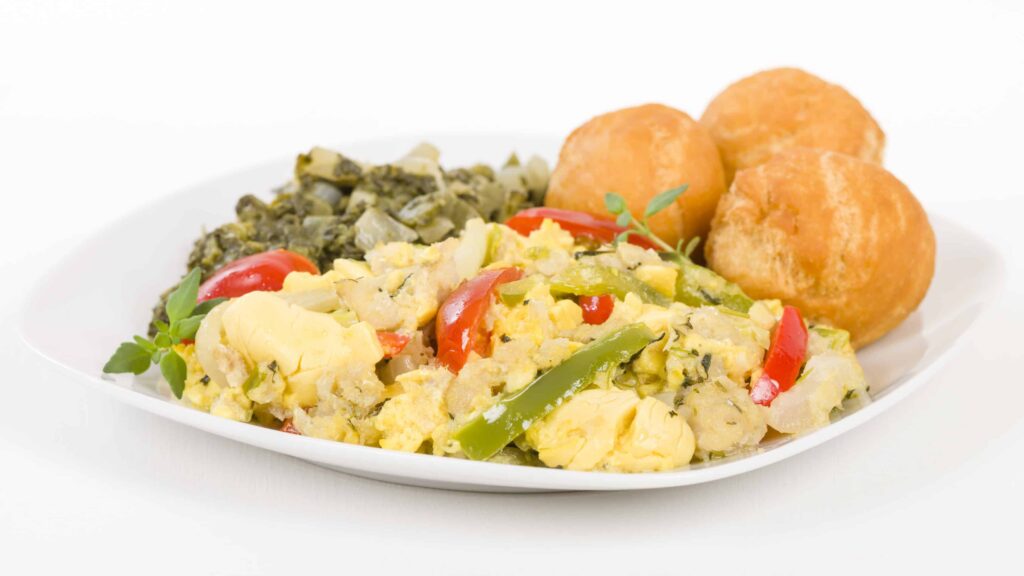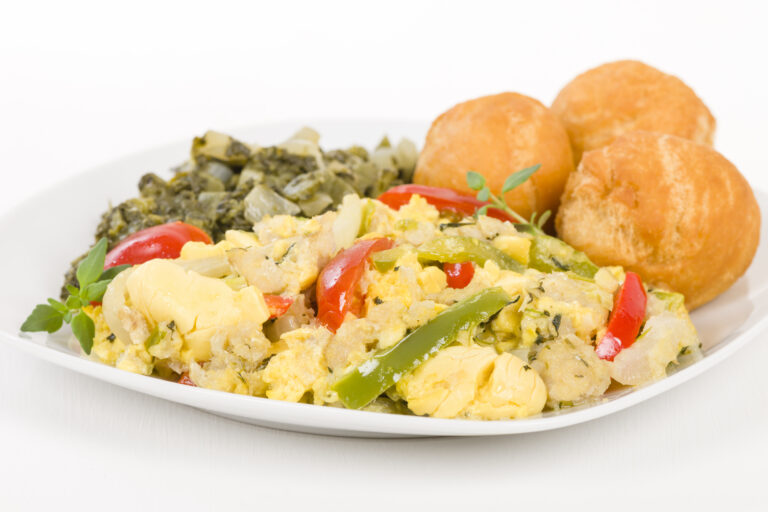
When you think of Jamaica, you might conjure images of white sandy beaches, reggae music, and the laid-back Caribbean vibe. But there’s more to this island nation than just its picturesque landscapes and infectious music. The heart of Jamaican culture can be found in its cuisine, and at the center of it all is Jamaica’s national dish – Ackee and Saltfish.
Ackee and Saltfish, a dish that has become synonymous with Jamaica’s vibrant culture and rich history is a meal often enjoyed at breakfast.
The dish is deeply rooted in the country’s past, reflecting its colonial history and African influences. Its popularity extends beyond Jamaica’s borders, making it an internationally recognized representation of Jamaican cuisine.
Our team at Remitly created this guide as part of our series that celebrates the culinary cuisine of our customers around the world.
The History of Ackee and Saltfish in Jamaica
The story of Ackee and Saltfish begins with the arrival of ackee to Jamaica. Native to West Africa, this fruit was brought to the island during the transatlantic slave trade in the 18th century. It quickly became popular due to its nutritional value and availability.
Saltfish, on the other hand, was introduced by European colonizers as a cheap source of protein for enslaved Africans. Over time, these two ingredients were combined to create what we now know as Ackee and Saltfish—a testament to resilience and creativity under harsh circumstances, cherished all over the Caribbean islands.
Ingredients Used in Preparing Ackee and Saltfish
The Ackee Fruit:
The star of the show, ackee, is often referred to as the “ackee fruit” or “ackee apple.” It grows on the ackee tree, originally native to West Africa but brought to the Caribbean during the colonial period.
The fruit, when ripe, bursts open to reveal three or four black seeds surrounded by a vibrant, fleshy yellow or red aril. The arils are what we use in the dish, but it’s important to note that the unripe ackee is toxic, so only the ripe fruit should be used in cooking.
Salted Codfish:
The other half of this dynamic duo is salted codfish. Salt cod, as it’s commonly known, is exactly what it sounds like – codfish preserved with a heavy salting process. This method of preservation allowed for fish to be transported across the Atlantic during the Transatlantic slave trade.
Recipe for Ackee and Saltfish
This recipe will guide you through the process of preparing your own Ackee and Saltfish at home. It’s a simple, straightforward method that captures the essence of this traditional Jamaican dish.
Ingredients
- 1 pound of salted codfish
- 2 cups of fresh ackee (or canned ackee if fresh isn’t available)
- 2 tablespoons of vegetable oil
- 1 small onion, diced
- 2 cloves of garlic, minced
- 2 sprigs of thyme (fresh is best, but dried works too)
- 1/2 Scotch bonnet pepper, seeded and minced (adjust to taste)
- 1/2 bell pepper, diced
- 2 scallions, chopped
- 1/4 teaspoon of black pepper
- 1/4 teaspoon of allspice (pimento)
- 2 medium-sized tomatoes, diced
- Salt (to taste)
- Water for boiling
- 2 tablespoons of vegetable oil for sautéing
Instructions
1. Prepare the Saltfish:
- Rinse the salted codfish in cold water to remove excess salt.
- In a large pot, add the codfish and cover it with cold water.
- Boil for about 20 minutes or until the fish flakes easily.
- Drain and flake the fish into small pieces.
2. Prepare the Ackee:
- If using fresh ackee, remove the seeds and any membrane.
- In a separate pot, boil the fresh ackee for about 15 minutes or until it’s soft. Be careful not to overcook, as ackee can become mushy.
- If using canned ackee, simply drain and set aside.
3. Sauté:
- In a skillet, heat the vegetable oil over medium heat.
- Add the onions, garlic, thyme, Scotch bonnet pepper, and bell pepper. Sauté until the vegetables are tender.
4. Combine:
- Add the flaked saltfish to the skillet and sauté for a few minutes to combine the flavors.
5. Mix in Ackee:
- Gently fold in the ackee to avoid breaking it into small pieces.
- Add scallions, black pepper, and allspice.
- Continue to sauté for another 5-7 minutes.
6. Add Tomatoes:
- Finally, add the diced tomatoes and cook for a few more minutes until they start to soften.
7. Season to Taste:
- Taste and adjust the seasoning, adding salt and extra Scotch bonnet pepper for more heat if needed.
Variations of the Dish Across Jamaica
While Ackee and Saltfish is a staple across Jamaica, variations exist depending on personal preference or regional influences. Some cooks might add additional spices or vegetables, while others may choose to serve it differently.
For instance, in some parts of Jamaica, Ackee and Saltfish might be served with breadfruit—an indigenous fruit often roasted or fried. In other areas, you might find it paired with “food”—a term used locally for provisions like yam, green banana, or dumplings.
Common Pairings with Ackee and Saltfish
Ackee and Saltfish is often served with traditional Jamaican side dishes. Here are some popular accompaniments:
Fried Dumplings:
Fried dumplings, also known as “Johnny Cakes,” are a delightful addition to the meal. These are simple doughy delights, fried to perfection.
Roast Breadfruit:
Breadfruit is a tropical fruit with starchy, potato-like flesh. It’s roasted until tender and served as a side dish.
Fried Plantain:
Ripe plantains are sliced and fried until they caramelize, providing a sweet and savory contrast to the dish.
Callaloo:
Callaloo is a Jamaican green leafy vegetable similar to spinach. It’s often cooked with seasonings and coconut milk, making it a great side dish or even a main course.
Hard Dough Bread:
This dense and slightly sweet bread is a Jamaican staple. It’s often served alongside Ackee and Saltfish.
Other Popular Jamaican Dishes
Jamaican cuisine offers a wide array of mouthwatering dishes. Here are a few more Jamaican classics you should definitely try:
1. Jerk Chicken:
Jerk chicken is marinated in a spicy blend of seasonings, including Scotch bonnet pepper, and grilled to perfection. The result is a smoky, spicy, and incredibly flavorful dish.
2. Rice and Peas:
Not to be confused with regular peas, “rice and peas” is a dish made with rice and kidney beans cooked in coconut milk and seasoned with thyme, scallions, and Scotch bonnet pepper.
3. Mannish Water:
Mannish Water is a traditional Jamaican soup made from the head and feet of a goat. It’s a spicy and hearty dish, often enjoyed for its unique flavors.
4. Jamaican Beef Patties:
These flaky pastries are filled with seasoned ground beef and often carry a bit of heat from Scotch bonnet pepper. They’re popular street food in Jamaica.
5. Sorrel Drink:
A refreshing Jamaican beverage made from the petals of the sorrel plant, it’s often enjoyed during the Christmas season.
The Importance of Spices
Spices play an integral role in Jamaican cooking. Allspice (also known as pimento), scotch bonnet peppers, thyme, ginger, nutmeg and cinnamon are commonly used to flavor dishes—giving them their distinctive taste.
Fruits and Vegetables
Jamaica’s tropical climate allows for a wide variety of fruits and vegetables to thrive. These include yams, breadfruit, plantains, ackee, mangoes, papayas—all of which feature prominently in local dishes.
In conclusion, Jamaican cuisine is a rich tapestry woven from its history and cultural influences—a testament to the island’s resilience and creativity. Whether you’re enjoying Ackee and Saltfish or any other traditional dish—you’re partaking in a piece of Jamaica’s vibrant culinary heritage.
Visit the homepage, download our app, or check out our Help Center to get started.
